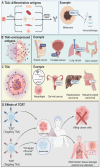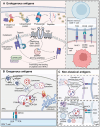Targeting cancer with precision: strategical insights into TCR-engineered T cell therapies
- PMID: 39744228
- PMCID: PMC11667231
- DOI: 10.7150/thno.104594
Targeting cancer with precision: strategical insights into TCR-engineered T cell therapies
Abstract
T cell receptor-engineered T (TCR-T) cell therapies are at the forefront of cancer immunotherapy, offering a transformative approach that significantly enhances the ability of T cells to recognize and eliminate cancer cells. This innovative method involves genetically modifying TCRs to increase their affinity for tumor-specific antigens. While these enhancements improve the ability of T cells to recognize and bind to antigens on cancer cells, rigorous assessment of specificity remains crucial to ensure safety and targeted responses. This dual focus on affinity and specificity holds significant promise for the treatment of solid tumors, enabling precise and efficient cancer cell recognition. Despite rapid advancements in TCR engineering and notable progress in TCR screening technologies, as evidenced by the growing number of specific TCRs entering clinical trials, several technical and clinical challenges remain. These challenges primarily pertain to the specificity, affinity, and safety of engineered TCRs. Moreover, the accurate identification and selection of TCRs that are both effective and safe are essential for the success of TCR-T cell therapies in cancer treatment. This review provides a comprehensive examination of the theoretical foundations of TCR therapy, explores strategies for screening specific TCRs and antigens, and highlights the ongoing challenges in this evolving therapeutic landscape.
Keywords: T cell receptor-engineered T cell therapy; cancer immunotherapy; screening strategy.
© The author(s).
Conflict of interest statement
Competing Interests: The authors have declared that no competing interest exists.
Figures






Similar articles
-
The recent advancement of TCR-T cell therapies for cancer treatment.Acta Biochim Biophys Sin (Shanghai). 2024 May 25;56(5):663-674. doi: 10.3724/abbs.2024034. Acta Biochim Biophys Sin (Shanghai). 2024. PMID: 38557898 Free PMC article. Review.
-
Exploiting TCR Repertoire Analysis to Select Therapeutic TCRs for Cancer Immunotherapy.Cells. 2025 Aug 7;14(15):1223. doi: 10.3390/cells14151223. Cells. 2025. PMID: 40801654 Free PMC article. Review.
-
Cancer immunotherapy with lymphocytes genetically engineered with T cell receptors for solid cancers.Immunol Lett. 2019 Dec;216:51-62. doi: 10.1016/j.imlet.2019.10.002. Epub 2019 Oct 6. Immunol Lett. 2019. PMID: 31597088 Review.
-
Engineered TCR-T Cell Immunotherapy in Anticancer Precision Medicine: Pros and Cons.Front Immunol. 2021 Mar 30;12:658753. doi: 10.3389/fimmu.2021.658753. eCollection 2021. Front Immunol. 2021. PMID: 33859650 Free PMC article. Review.
-
Generation of effective and specific human TCRs against tumor/testis antigen NY-ESO-1 in mice with humanized T cell recognition system.Front Immunol. 2024 Dec 24;15:1524629. doi: 10.3389/fimmu.2024.1524629. eCollection 2024. Front Immunol. 2024. PMID: 39776913 Free PMC article.
Cited by
-
Decoding MHC loss: Molecular mechanisms and implications for immune resistance in cancer.Clin Transl Med. 2025 Jul;15(7):e70403. doi: 10.1002/ctm2.70403. Clin Transl Med. 2025. PMID: 40673641 Free PMC article. Review.
-
Emerging frontiers in adoptive cell therapies: innovations, challenges, and future perspectives.Med Oncol. 2025 Jun 15;42(7):261. doi: 10.1007/s12032-025-02808-z. Med Oncol. 2025. PMID: 40517350 Review.
-
Clinical development of immuno-oncology therapeutics.Cancer Lett. 2025 May 1;617:217616. doi: 10.1016/j.canlet.2025.217616. Epub 2025 Mar 6. Cancer Lett. 2025. PMID: 40054657 Review.
-
CD8+ T Cell Subsets as Biomarkers for Predicting Checkpoint Therapy Outcomes in Cancer Immunotherapy.Biomedicines. 2025 Apr 9;13(4):930. doi: 10.3390/biomedicines13040930. Biomedicines. 2025. PMID: 40299510 Free PMC article. Review.
-
Computation strategies and clinical applications in neoantigen discovery towards precision cancer immunotherapy.Biomark Res. 2025 Jul 9;13(1):96. doi: 10.1186/s40364-025-00808-9. Biomark Res. 2025. PMID: 40629481 Free PMC article. Review.
References
-
- Jhunjhunwala S, Hammer C, Delamarre L. Antigen presentation in cancer: insights into tumour immunogenicity and immune evasion. Nat Rev Cancer. 2021;21:298–312. - PubMed
Publication types
MeSH terms
Substances
LinkOut - more resources
Full Text Sources
Other Literature Sources
Medical

